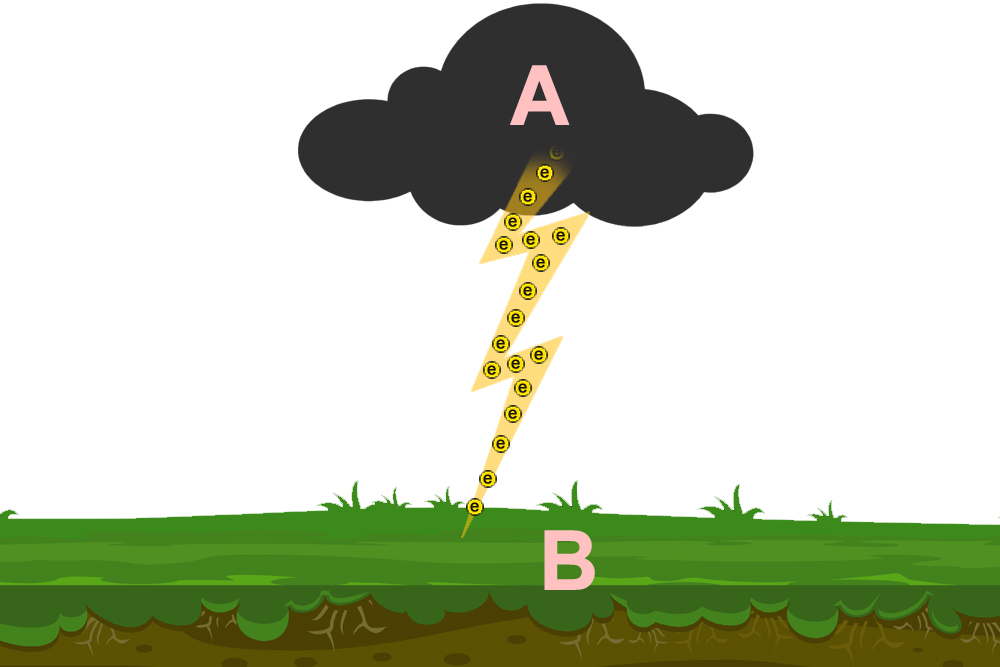Table of Contents (click to expand)
While wearing a suit of armor and crouching may seem like viable options for surviving a lightning strike, FEMA recommends following the 30/30 rule during thunderstorms.
It’s common to see the iconic image of a person getting struck by lightning in movies or cartoons. Although this depiction is somewhat accurate, lightning strikes can cause severe burns and injuries in humans.
Although the chances of getting struck by lightning are very low, it’s still important to know the best ways to stay safe in case it happens. What’s the safest clothing and position to protect yourself from lightning strikes?
Before we explore the answer to this question, let’s understand what lightning is and the kind of damage it can cause.
Recommended Video for you:
What Causes Lightning?
Lightning is caused by the collision of ice particles with a cloud with an excessive negative charge. This strong charge repels electrons towards the ground, turning it into a positively charged end.
Lightning discharges to the ground as a powerful force that races towards it at the speed of light, around 3,00,000 km/hour, striking it with a force of 300 KV. This is roughly 150 times more powerful than a household’s electrical supply, posing a significant risk of severe physical and mental injury.
If someone is struck by lightning, they are likely to suffer a third-degree burn, and their clothes or hair may even catch fire. Sometimes, lightning strikes can be so devastating that they knock off a person’s shoes! A victim recalls that the pain is like thousands of wasps simultaneously stinging from within.

Lightning strikes carry thousands of volts, which means that if someone is struck directly on the head, it can result in severe nerve damage. This can lead to cognitive problems such as memory loss and even personality changes.
In a peculiar incident a few years ago, an orthopedic surgeon was struck by lightning, which led to an inscrutable urge to play the piano. He began composing music and claimed that the music lingers around his head ever since the strike. After a few months, he abandoned his profession as a surgeon and switched to music!
How To Survive A Lightning Strike?
Clothing
Before discussing the details of surviving a lightning strike by wearing the right garment or taking the right protective pose, let’s start with a small test.
Imagine you’re in a large open field during a violent thunderstorm and choose the option that you think is most likely to keep you safe from a lightning strike:
a. A raincoat
b. A superhero costume
c. Medieval metallic armor
d. Normal daily wear (e.g., jeans and a t-shirt)
If you guessed medieval metallic armor, you are correct!
This may surprise many, but metallic armor would be the safest option, contrary to popular belief.

Physics Of Lightning
Electricity is often associated with power plants and the sockets in our homes, but it is actually present almost everywhere. Even in things like clouds, pets, and the chair you are sitting on right now! Lightning, for instance, is simply a form of electricity. It is a long stream of fast-moving electrons that are trying to find the quickest path from the clouds to the ground.
Some people might think that wearing a raincoat or a superhero costume would protect them from a lightning strike, but in reality, metallic armor is the best protection. Why? Because the metal attracts the lightning and provides the easiest path for it to follow, rather than passing through your body.

Faraday Cage
It is interesting to note that metals attract lightning for the same reason that they help to protect us from it. This is because metals are good conductors of electricity. When it comes to metallic conductors, electrons can easily move along a metallic surface without the need to penetrate deep into the surface.
This is similar to a hollow metallic container, where if it is connected to a battery so that a current can pass through it, the current won’t reach the stuff stored inside. This is called a Faraday cage. Your metallic armor would behave like a Faraday cage, passing current from the outer metallic body quickly to the ground while shielding the person inside.

Electricians working on high-voltage transmission lines often wear steel-woven garments, known as a Faraday suit.
Your car is somewhat like a Faraday cage. Apart from the rubber tires, a car is made up of a closed metal frame that is likely to keep you safe in the event of a lightning strike. It will channel the electrons around the outer surface to the ground rather than through your body.
However, it’s important to note that the effectiveness of the Faraday cage in your car depends on the quality of the metal used in the car’s frame. If the metal is substandard, then your car may not be able to protect you as well. Also, premium convertible cars do not have metal roofs, making them more dangerous during lightning strikes.

However, what if you’re far away from your car and get caught on open ground during a storm? Chances are very small that you’ll conveniently be wearing medieval armor or a professional Faraday suit. In that case, your next best survival bet would be adopting the right body posture.
Pose
Obviously, there is no guaranteed way of predicting when lightning will strike, but some telltale signs should urge you to take shelter before lighting descends around you. A tingling sensation on the skin, hairs on your arm/neck standing up, or hearing an inexplicable clicking sound could all be harbingers of an imminent lightning strike. Also, if you notice an unusual but dull bluish-white glow on the metal, there is a strong chance of a lightning storm. If you can’t find shelter, the only way to minimize the risk of a lightning strike is to diminish your body posture while keeping your “footprint” small.
Experts suggest crouching down and bowing your head between your knees. Standing upright would give lighting the fastest route to the ground, whereas lying completely flat on the ground exposes a large part of your body to the ground, which might be carrying current due to a strike nearby. Therefore, standing straight or sleeping on the ground are both riskier during a lightning strike.

A crouched posture aims to get close to the ground with minimal direct contact, i.e., only with your feet. It’s important not to touch the ground with your hands. Instead, cover your ears with your hands because, during a lightning strike, your ears would be highly vulnerable to damage; covering your ears can minimize any loss of hearing. Crouching down will not shield you entirely if lightning strikes, but it might contain the damage. Putting your head down, for example, would protect your brain from being the most likely strike point.
Other Safeguards
Using a medieval suit of armor and crouching down are theoretical remedies for surviving a lightning strike. However, when it comes to the real world, it’s better not to venture out in armor or stand in an open field during a lightning storm to check the veracity of these strategies. Whenever there is lightning, you should stay indoors within a safe shelter.
The Federal Emergency Management Agency (FEMA) recommends that people follow the 30/30 rule when a thunderstorm is approaching.
The rule says: If you hear thunder within 30 seconds of a lightning flash, it means that lightning has struck nearby. Seek shelter immediately and wait for at least 30 minutes after the last clap of thunder before going back outside.
Keep in mind that sheds, dugouts, or bus shelters do not provide adequate protection against lightning strikes. Instead, find a sturdy building with wiring and plumbing that can divert and channel electrons in case of a strike.
If you’re in a jungle and can’t find a sturdy building, try to find a dense population of small trees to huddle under. Avoid tall trees, as they are more likely to be hit by lightning and can even explode!
Once you’re safe indoors, avoid using the telephone. If the telephone line is struck by lightning, the current could travel through the same line to your phone.
In short, don’t take any chances with lightning. While the odds of being struck are low, it’s better to be safe than sorry. Stay indoors during thunderstorms and enjoy the show from a safe distance!
Last Updated By: Ashish Tiwari













